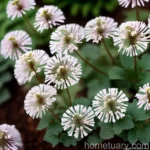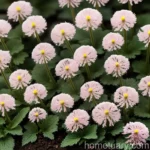All About Foam Flower (Tiarella ‘Tntia041’ STARGAZER MERCURY)
What is Foam Flower (Tiarella ‘Tntia041’ STARGAZER MERCURY)?
Foam flower, scientifically known as Tiarella ‘Tntia041’ STARGAZER MERCURY, is a delightful and delicate perennial plant known for its stunning foliage and charming blooms. It belongs to the family Saxifragaceae and is native to North America. ‘Tntia041’ STARGAZER MERCURY is a hybrid variety that has captured the attention of gardeners and plant enthusiasts due to its unique characteristics and ease of cultivation.
Key Takeaways
- Plant Name: Tiarella ‘Tntia041’ STARGAZER MERCURY
- Common Name: Foam Flower
- Family: Saxifragaceae
- Native Range: North America
- Hybrid Variety: ‘Tntia041’ STARGAZER MERCURY
Culture
Foam flower is an excellent addition to any garden, offering not only aesthetic appeal but also easy maintenance. Its culture requirements are relatively straightforward, making it a popular choice for both novice and seasoned gardeners.
Uses
- Garden Borders: Its low-growing nature and charming blooms make it an ideal candidate for garden borders and edges.
- Ground Cover: Foam flower serves as an attractive ground cover, filling in spaces with its lush foliage and delicate flowers.
- Containers: Due to its compact size, it can thrive in containers, adding a touch of elegance to patios, balconies, and other outdoor spaces.
Water
Foam flower thrives in consistently moist soil, making it well-suited for shaded or woodland gardens where the soil tends to retain moisture. It is important to ensure that the soil is well-draining to prevent waterlogging, which can lead to root rot.
Sunlight
While foam flower prefers partial to full shade, it can also tolerate some morning sun. In warmer regions, providing it with dappled sunlight or partial shade is crucial for its overall health and vigor.
Fertilizer
A balanced, slow-release fertilizer applied in early spring can support the growth and blooming of foam flower. It is important to follow the recommended application rates to avoid over-fertilization, which can adversely affect the plant.
Soil
The ideal soil for foam flower is rich in organic matter and well-draining. A mix of compost or peat moss can be incorporated into the soil to improve its texture and water retention capabilities. A slightly acidic to neutral pH range is optimal for this plant.
Pruning
Pruning foam flower is relatively minimal and is primarily focused on removing spent blooms and dead foliage. This encourages the plant to continue producing new flowers and maintains its overall appearance.
Propagation
Foam flower can be propagated through division or by collecting seeds. Division is often the preferred method as it allows for the creation of new plants from an existing one, and it is relatively easy to do.
Container Popularity
Foam flower is an excellent choice for container gardening, particularly for those living in urban environments or with limited outdoor space. Its compact growth habit and attractive foliage make it a versatile plant for various container designs.
Common Diseases
Foam flower is generally resistant to most common plant diseases, particularly when grown in suitable conditions. However, certain environmental stressors or poor cultural practices can make it susceptible to specific issues.
Disease Diagnosis
- Powdery Mildew: When grown in humid or poorly ventilated conditions, foam flower may develop powdery mildew, which appears as a white powdery substance on the leaves.
- Crown Rot: Overly wet soils or poor drainage can lead to crown rot, causing the plant to wilt and exhibit root discoloration.
Common Pests
Foam flower is relatively resistant to pest infestations. However, certain pests may still target this plant under specific conditions.
Botanist’s Tips
- Mulching: Applying a layer of mulch around foam flower helps to conserve soil moisture, suppress weeds, and protect the roots during extreme temperatures.
- Regular Watering: Consistent moisture is key to the health and vitality of foam flower, particularly during the growing season.
Fun Facts
- The name “foam flower” is derived from its delicate, frothy blooms that resemble foam.
- This plant was historically used by Native American tribes for its medicinal properties, often employed to treat various ailments.
Links to External Resources
- Tiarella ‘Tntia041’ STARGAZER MERCURY – Plant Profile
- Foam Flower Care Tips
- Tiarella ‘Tntia041’ STARGAZER MERCURY Propagation Guide
Conclusion
Foam flower (Tiarella ‘Tntia041’ STARGAZER MERCURY) is an enchanting and versatile plant well-suited for a variety of garden settings. Its ease of cultivation, charming blooms, and attractive foliage make it a delightful addition to any landscape. By understanding its culture, care requirements, and unique characteristics, gardeners can enjoy the beauty that foam flower brings to their outdoor spaces.
Remember, while foam flower can thrive with minimal care, providing it with the right growing conditions and attention ensures that it flourishes and continues to enhance the beauty of gardens for years to come.















